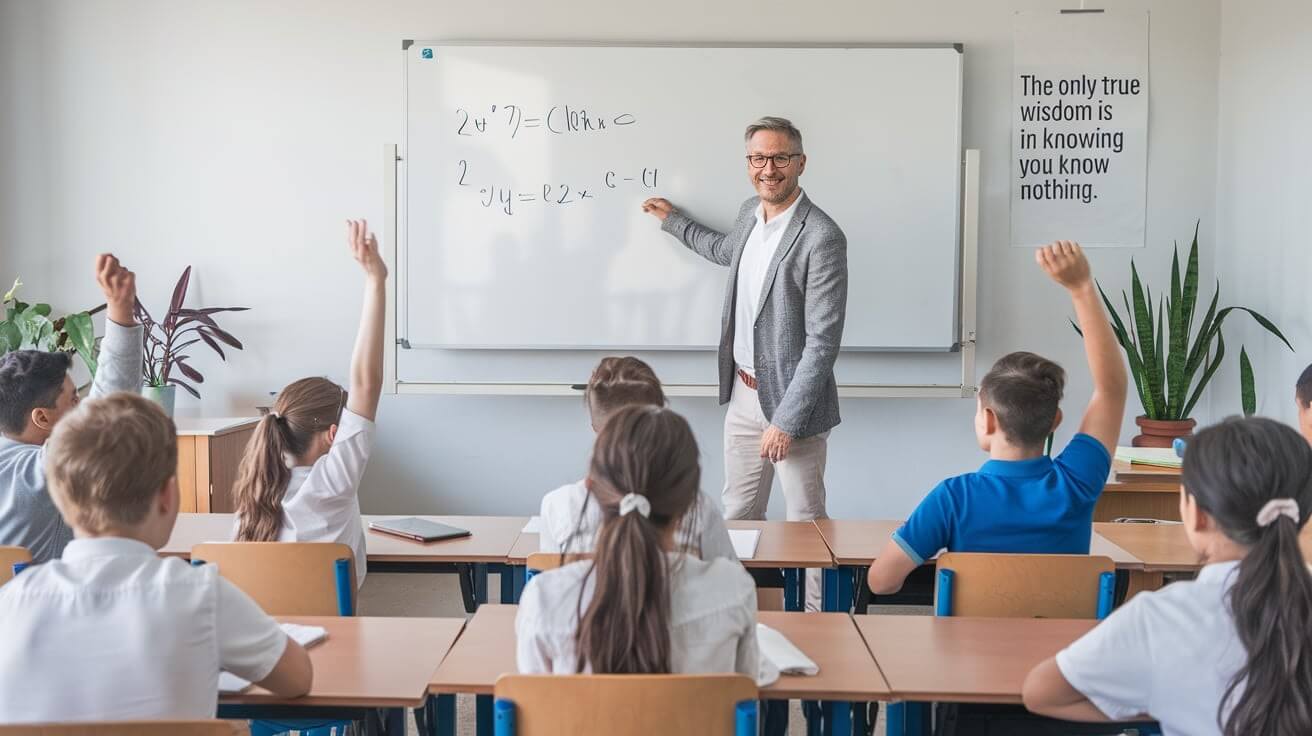
Critical Thinking in the Classroom Strategies for Educators
Facilitating critical thinking in the classroom is not just about teaching students to analyze information—it's about preparing them to navigate challenges, solve problems, and make informed decisions in everyday life.
As an educator, you have the unique opportunity to cultivate this essential skill, turning passive learners into active thinkers who engage deeply with the world around them.
This article will explore practical strategies, actionable tips, and relatable examples to help you integrate critical thinking into your teaching.
Whether you're a new teacher or have years of experience, this guide offers actionable insights to help enhance your classroom practices.
Understanding Critical Thinking
Critical thinking involves analyzing information, evaluating evidence, and making reasoned judgments. It goes beyond memorizing facts and encourages students to question assumptions, explore alternative viewpoints, and draw logical conclusions.
Why it Matters in Education
Developing critical thinking skills benefits students in many ways:
-
It enhances problem-solving abilities.
-
It fosters curiosity and creativity.
-
It helps students make informed decisions, both academically and personally.
-
Research by The Foundation for Critical Thinking highlights that students who engage in critical thinking perform better academically and are more equipped to handle real-world challenges.

Challenges in Teaching Critical Thinking
1. Rigid Curricula
Many educators face strict curricula that leave little room for creative thinking exercises. Focusing on standardized testing requirements often takes priority, leaving little room for activities encouraging students to think independently and develop their ideas.
Integrate critical thinking into existing lesson plans by framing discussions around open-ended questions and encouraging exploratory activities that align with curriculum goals.
2. Limited Classroom Time
Time constraints make incorporating new teaching strategies difficult. Teachers often feel pressured to cover material quickly, leaving little space for deeper engagement.
Use quick but impactful methods like brainstorming sessions or short problem-solving exercises to encourage active participation.
3. Diverse Student Abilities
Classrooms often have a wide range of skill levels, making it challenging to design activities that engage all students equally.
Provide tiered activities where tasks are adjusted to different skill levels, ensuring inclusivity while maintaining the focus on critical thinking.
Strategies to Develop Critical Thinking
1. Socratic Questioning
Socratic questioning encourages students to think critically by probing their assumptions and reasoning. Instead of giving answers, ask open-ended questions like:
-
"What evidence supports your view?"
-
"What alternatives could we consider?"
During a literature class, ask, "Why do you think the author chose this ending? How might it change if the story took place in another setting?"
2. Problem-Based Learning (PBL)
PBL involves presenting real-world problems for students to solve collaboratively. This method fosters teamwork, research skills, and practical application of knowledge.
Assign students to design a sustainable energy plan for their school. This project would require them to research, analyze costs, and present a feasible solution.
4. Reflective Practices
Encourage students to reflect on their learning through journals, self-evaluations, or group discussions. Reflection helps students internalize concepts and assess their reasoning processes.
After completing a group project, ask students to write about what went well, what challenges they faced, and what they would do differently next time.
Engaging Activities for Critical Thinking in the Classroom

Fostering critical thinking in students requires interactive and thought-provoking activities. Here are three effective methods:
1. Group Discussions and Debates
Group discussions and debates help students express their ideas, listen actively, and explore different viewpoints. This process enhances their analytical skills and promotes open-mindedness.
Organize a debate on a topic like "Should schools implement uniforms?" Ensure students research their positions and respond thoughtfully to counterarguments.
Benefits:
-
Students learn to communicate their thoughts clearly and listen actively.
-
Evaluating different viewpoints fosters insights
-
Public speaking in a structured environment boosts self-assurance.
Implementation Tips:
-
Define clear rules and roles to maintain focus.
-
Choose subjects relevant to student's interests to increase engagement.
-
After debates, discuss what was learned to reinforce critical thinking.
2. Case Studies and Real-World Scenarios
Utilizing case studies allows students to apply theoretical knowledge to practical situations, enhancing their problem-solving and decision-making abilities.
Present a case study about environmental conservation. Ask students to evaluate different conservation methods and decide which would work best in their community.
Benefits:
-
Connects theoretical knowledge to real-world practice, making learning more meaningful and relevant.
-
Encourages evaluation of complex information.
-
Promotes teamwork and diverse perspectives.
Implementation Tips:
-
Choose case studies that resonate with students' experiences.
-
Provide frameworks to help students dissect cases effectively.
-
Encourage open dialogue to explore various solutions.
3. Role-Playing
Role-playing activities immerse students in different perspectives, fostering empathy, insight, and understanding of complex issues.
In a history lesson, assign students roles as historical figures during a pivotal event. Ask them to debate decisions from their assigned perspectives.
Benefits:
-
Understanding others' viewpoints enhances social awareness.
-
Interactive learning keeps students motivated.
-
Analyzing decisions from various angles promotes deeper insight.
Implementation Tips:
-
Define the purpose and expected outcomes of the role-play.
-
Provide background information to help students embody their roles authentically.
-
Discuss the experience afterward to solidify learning and address any misconceptions.
Tools and Resources for Teachers
Equipping educators with practical tools and resources is essential for fostering critical thinking in students. Below are key strategies and their practical applications:
1. Concept Mapping Tools
Concept maps are visual representations that illustrate the relationships between ideas, aiding in the organization and integration of knowledge. Utilizing digital tools like MindMeister and Lucidchart can enhance this process. MindMeister offers an intuitive platform for creating and sharing mind maps, facilitating collaborative learning. Lucidchart provides a versatile diagramming tool that integrates seamlessly with other applications, supporting diverse educational needs.
In a history lesson, students can use these tools to map out the causes and effects of a significant event, such as the Industrial Revolution. This activity encourages them to identify and analyze connections they might not have noticed otherwise, deepening their understanding of historical complexities.
Benefits:
-
Visualizing information makes it easier for students to understand complex ideas.
-
Interactive mapping promotes active engagement and teamwork among students.
-
Using visual tools to organize information helps students identify connections and patterns, which fosters critical thinking.
Implementation Tips:
-
Provide students with guidelines on how to create and interpret concept maps.
-
Align mapping activities with learning objectives to reinforce the subject matter.
-
Encourage group work to enhance communication and teamwork skills.
2. Assessment Techniques
Evaluating critical thinking skills requires diverse and reflective assessment methods. Traditional tests may not fully capture a student's analytical abilities; therefore, incorporating rubrics, reflective essays, and project-based evaluations can provide a more comprehensive assessment.
Develop a rubric to assess students' abilities to analyze evidence, construct coherent arguments, and articulate conclusions in written assignments. This rubric can include criteria such as clarity of thought, depth of analysis, and originality.
Benefits:
-
Multiple assessment methods offer a holistic view of students' critical thinking capabilities.
-
Detailed rubrics provide specific insights into areas of strength and improvement.
-
Reflective essays encourage self-assessment and continuous learning.
Implementation Tips:
-
Share rubrics with students beforehand to set clear expectations.
-
Incorporate various formats to cater to different learning styles.
-
Provide up-to-date and constructive feedback to guide student development.
3. Professional Development
Regular learning is essential for educators to teach critical thinking skills effectively. Engaging in workshops, webinars, and courses on critical thinking strategies can enhance teaching methodologies.
Organizations like The Foundation for Critical Thinking offer resources and programs to develop these skills. Additionally, local educational institutions often provide professional development opportunities tailored to educators' needs.
Participate in programs that offer practical strategies and tools for integrating critical thinking into the classroom. Engaging with professional communities can also provide support and shared experiences.
Benefits:
-
Exposure to new methodologies can improve instructional effectiveness.
-
Connecting with other educators fosters collaboration and idea exchange.
-
Keeping current educational trends ensures relevant and engaging teaching practices.
Implementation Tips:
-
Allocate time for regular professional development activities.
-
Engage in group learning sessions to benefit from diverse perspectives.
-
Implement new strategies in the classroom and reflect on their effectiveness.
Measuring the Impact of Critical Thinking
1. Tracking Progress
Use formative assessments such as quizzes, journals, or peer reviews to monitor students' growth in critical thinking.
Example: Implement a "before and after" assessment to measure how students approach problem-solving at the start and end of a term.
2. Adapting Based on Feedback
Gather feedback from students about which activities they find most engaging and effective. Use this input to refine your teaching methods.
Conclusion
Developing critical thinking in the classroom is a rewarding journey. Using techniques like Socratic questioning, problem-based learning, and reflective practices, you can transform your teaching and empower students to think independently.
Start small, experiment with new methods, and adapt your approach to student needs. The result? Confident, curious learners who are prepared for anything life throws their way.
Key Takeaways:
-
Critical thinking is teachable and transformative.
-
Practical activities like debates and role-playing make learning engaging.
-
Regular reflection and feedback help fine-tune your strategies.
Let's nurture the thinkers of tomorrow, starting in today's classrooms.
Frequently Asked Questions (FAQs)
How can teachers integrate critical thinking into everyday lessons?
Teachers can integrate critical thinking by using open-ended questions, encouraging group discussions, and incorporating activities like debates, role-playing, and case studies. For example, instead of asking factual questions, ask students to explain their reasoning or consider alternative solutions to problems.
What are some tools that help in teaching critical thinking?
Concept mapping tools like MindMeister and Lucidchart are excellent for visualizing relationships between ideas. Rubrics, reflective essays, and project-based assessments help evaluate critical thinking skills effectively.
Why is critical thinking important in education?
Critical thinking equips students to analyze information, solve problems, and make informed decisions. It fosters independence, creativity, and the ability to adapt to new challenges, skills essential for academic and personal success.
How can teachers assess critical thinking in students?
Teachers can use rubrics with clear criteria to evaluate skills like analysis, argumentation, and evidence interpretation. Reflective essays and group projects also provide insight into how students approach problem-solving and decision-making.
Are there professional development programs for teaching critical thinking?
Yes, organizations like The Foundation for Critical Thinking and local educational institutions offer workshops and webinars to help teachers learn strategies for fostering critical thinking. Participating in these programs provides practical tools and keeps educators updated on best practices.
Critical Thinking Skills





